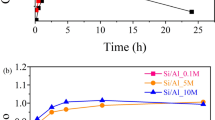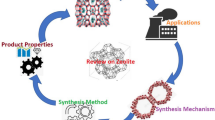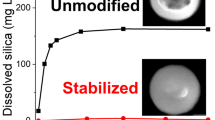Abstract
By means of the concept of universal optimum and general principles of inorganic gene, structures of paulingite-related zeolites and minerals have been constructed. The structures of zeolite Rho and paulingite are considered as members of zeolite family generated by the work of 4-colored cellular automaton (CA). The ideal symmetry of the members of the family is cubic, space group \(Im \bar 3m\), a = 15 + 10n [Å], where n is a number of the CA cycle (n = 0 for zeolite Rho and 2 for paulingite). A new hypothetical zeolite of the family with n = 1 is predicted and named ISC-1 (Institute of Silicate Chemistry-1); atomic coordinates and theoretical X-ray powder diffraction pattern have been calculated. It appears to be very probable that universal optimum contains all necessary information for its material realization (sharp configurations) and construction of materials with certain type of interaction potential (even with restrictions existing in theory for this potential).





Similar content being viewed by others
Notes
We have chosen paulingite because the question ‘Where are genes in paulingite?’ had been asked first in the paper of A.L. Mackay "Generalised crystallography" Journal of Molecular Structure (Teochem) 336 (1995) 293–303.
References
Mackay AL (1967) Nature 216:159
Cohn H, Kumar AJ (2007) Am Math Soc 20:99
Ballinger B, Bleknerman G, Cohn H, Giansiracusa N, Kelly E, Schurmann A. Experimental study of energy-minimizing point configurations on spheres. arxiv:math.MG/0611451
Gordon EK, Samson S, Kamb WB (1966) Science 154:1004
Passaglia E, Gualtieri AF, Marchi E (2001) Eur J Miner 13:113
Vaughan DEW, Strohmaier KG (1999) Microporous Mesoporous Mater 28:233
Baerlocher Ch, Meier WM, Olson DH (2001) Atlas of zeolite framework types. Amsterdam, Elsevier
Friedrichs OD, Dress AWM, Huson D, Klinowski J, Mackay AL (1999) Nature 400:644
Toffoli T, Margolus N (1987) Cellular automata machines: a new environment for modeling. Boston, MIT Press
Mackay AL (1976) Phys Bull 495
Krivovichev SV (2004) Acta Crystallogr A60:257
Robson HE, Shoemaker DP, Ogivie RA, Manor PC (1973) Adv Chem Ser 121:106
McCusker LB (1984) Zeolites 4:51
Parise JB, Gier TE, Corbin DR, Cox DE (1984) J Phys Chem 88:1635
Author information
Authors and Affiliations
Corresponding author
Rights and permissions
About this article
Cite this article
Shevchenko, V.Y., Krivovichev, S.V. Where are genes in paulingite? Mathematical principles of formation of inorganic materials on the atomic level. Struct Chem 19, 571–577 (2008). https://doi.org/10.1007/s11224-008-9327-6
Received:
Accepted:
Published:
Issue Date:
DOI: https://doi.org/10.1007/s11224-008-9327-6




